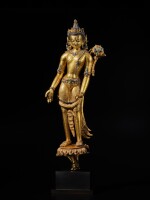Dharma and Tantra, including Masterpieces from the Nyingjei Lam Collection
Dharma and Tantra, including Masterpieces from the Nyingjei Lam Collection

Property of a Lady
A large silver and semi-precious stone-inlaid gilt-copper alloy figure of Padmapani, Tibet, 14th / 15th century
Auction Closed
September 18, 04:57 PM GMT
Estimate
300,000 - 400,000 USD
Lot Details
Description
A large silver and semi-precious stone-inlaid gilt-copper alloy figure of Padmapani
Tibet, 14th / 15th century
銅合金鎏金錯銀嵌寶蓮華手菩薩立像
西藏 十四 / 十五世紀
Himalayan Art Resources item no. 61740.
HAR編號61740
Overall height 21⅞ in., 55.7 cm
Benny Rustenberg, Hong Kong.
European Private Collection, acquired in 1998.
Bonhams Hong Kong, 2nd October 2018, lot 43.
Benny Rustenberg,香港
歐洲私人收藏,得於1998
香港邦瀚斯2018年10月2日,編號43
Padmapani is depicted with right hand lowered and palm open in the boon-granting gesture (varada mudra), the left holding the stem of a flowering lotus, the richly gilded figure adorned with gem-set jewelry, inlaid silver beading on the crown-band, necklace, belt, and sacred cord (yajnopavita), wearing a patterned dhoti and a sash around the hips with a long scarf-end at the side, and standing in a relaxed thrice-bent posture (tribhanga) on a lotus flower with supporting stem.
This elegant figure is the epitome of the Nepalese sculptural style that was popular with Tibetan patrons in the fourteenth and fifteenth centuries. The source of the style is evident in a fourteenth century gilt-copper Avalokiteshvara cast in the Kathmandu Valley with similar posture, jewelry, Garuda crown, ‘rice-grain’ pattern on the hem of the dhoti, and the sash over the thighs, see Helmut Uhlig, On the Path to Enlightenment: The Berti Aschmann Foundation of Tibetan Art at the Museum Rietberg Zürich, Zürich, 1995, cat. no. 51. The principal difference to the Kathmandu model is the inlaid silver beading which is a key indication of a Tibetan rather than Nepalese provenance. Silver inlay on Tibetan gilt bronzes appears by at least the thirteenth or fourteenth century, as seen on two gilt Taras in Tibetan monastery collections, see Ulrich von Schroeder, Buddhist Sculptures in Tibet, vol. II, Hong Kong, 2001, pls 257A-B.
The lotus stem projecting from the base of the statue indicates the bronze is from a larger setting. The figure is likely to have been one of a pair of standing bodhisattvas fitted into a separately cast pedestal by means of the projecting lotus stems, and forming a triad with a Buddha or Tathagata at the center, probably a large seated figure with the two bodhisattvas standing either side. This arrangement is a common theme in early central Tibetan painting, such as a set of three early Nepalese style Tibetan thangkas depicting seated Tathagatas and attendant bodhisattvas standing on individual lotus stems emerging from the throne, see Steven Kossak and Jane Casey Singer, Sacred Visions: Early Paintings from Central Tibet, New York, 1998, cat. nos 36A, B, C. The composition of the paintings give context to this standing gilt bronze and an indication of the scale of a central Buddha figure in relation to the attendant bodhisattvas. A fifteenth -century central Tibetan gilt-copper Akshobhya Buddha in Nepalese style provides evidence of just such a triad in this period, see Jeff Watt, David Pritzker et al., Zhiguan Museum of Fine Art, Beijing, 2018, pp 200-213. The Buddha’s pedestal is cast with additional lotus flowers and stems at either side with slots to facilitate the attachment of a pair of attendants, probably standing bodhisattvas like this Avalokiteshvara. This fine silver inlaid standing figure is thus likely to have been part of just such a group, though much larger and surely one of the most spectacular gilt bronze installations in central Tibet at this time.
此尊立像秀逸絕塵,集尼泊爾造像風格於一身,十四至十五世紀備受西藏供養人尊崇。此風格源頭可溯至十四世紀加德滿都谷地一尊銅鎏金觀世音菩薩像,無論體態、瓔珞、迦樓羅寶冠、裹裙邊紋飾或腿前衣帶,無一不似,見Helmut Uhlig,《On the Path to Enlightenment: The Berti Aschmann Foundation of Tibetan Art at the Museum Rietberg Zürich》,蘇黎士,1995年,編號51。較之加德滿都原型,此尊主要區別在於串珠錯銀,彰顯此尊西藏特色,亦知其非尼泊爾所出。西藏銅鎏金造像以錯銀為飾乃初見於十三至十四世紀,可比鎏金度母像兩尊,西藏寺院供奉,錄烏爾裡希.馮.施羅德在《西藏佛教雕塑》,卷II,香港,2001年,圖版257A-B。
蓮花莖起自底座,可知此立像為較大組像中一尊,此尊或為一對脅侍菩薩之一,組像主尊則為佛或如來,應為坐像,由二菩薩脅侍左右。主尊及脅侍菩薩乃早期藏中繪畫常見題材,可比早期尼泊爾風格西藏唐卡一組三幅,主尊如來佛坐像及脅侍菩薩,菩薩各立蓮花座上,蓮莖與主尊座相連,見Steven Kossak及Jane Casey Singer,《Sacred Visions: Early Paintings from Central Tibet》,紐約,1998年,頁138-43,編號36A、B、C。上述唐卡格局為此尊銅鎏金立像提供背景,亦為主尊與脅侍菩薩之比例提供線索。比一尊十五世紀藏中銅鎏金阿閦佛,尼泊爾風格,可為此時期三聖像提供依據,見傑夫.瓦特、David Pritzker等,《止觀美術館》,北京,2018年,頁200-213。佛底座各側鑄有蓮花及花莖,有接口可連脅侍菩薩一對,脅侍菩薩或如此尊觀世音立像。此錯銀尊觀世音立像便應原屬此類組像,且尺寸魁碩,可知原組像應為該時期藏中銅鎏金造像組之殊罕精品。
